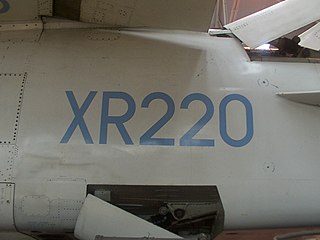See also
- Aircraft livery, the full graphic treatment of aircraft, often for branding
- All pages with titles containing Aircraft marking
- Marking (disambiguation)
Aircraft markings are symbols and annotations painted on aircraft, primarily for visual identification. Types of aircraft markings include:

A serial number is a unique identifier used to uniquely identify an item, and is usually assigned incrementally or sequentially.

Nose art is a decorative painting or design on the fuselage of an aircraft, usually on the front fuselage.

A roundel is a circular disc used as a symbol. The term is used in heraldry, but also commonly used to refer to a type of national insignia used on military aircraft, generally circular in shape and usually comprising concentric rings of different colours. Other symbols also often use round shapes.

An aircraft registration is a code unique to a single aircraft, required by international convention to be marked on the exterior of every civil aircraft. The registration indicates the aircraft's country of registration, and functions much like an automobile license plate or a ship registration. This code must also appear in its Certificate of Registration, issued by the relevant civil aviation authority (CAA). An aircraft can only have one registration, in one jurisdiction, though it is changeable over the life of the aircraft.

Anti-flash white is a white colour commonly seen on British, Soviet, and U.S. nuclear bombers. The purpose of the colour is to reflect some of the thermal radiation from a nuclear explosion, protecting the aircraft and its occupants.

USAAF unit identification aircraft markings, commonly called "tail markings" after their most frequent location, were numbers, letters, geometric symbols, and colors painted onto the tails, wings, or fuselages of the aircraft of the United States Army Air Forces (USAAF) during the Second World War.

Tail codes are markings usually on the vertical stabilizer of U.S. military aircraft that help identify the aircraft's unit and/or base assignment. This is not the same as the serial number, bureau number, or aircraft registration which provide unique aircraft identification.

The air forces of the United Kingdom – the Royal Navy's Fleet Air Arm, the Army's Army Air Corps and the Royal Air Force use a roundel, a circular identification mark, painted on aircraft to identify them to other aircraft and ground forces. In one form or another, it has been used on British military aircraft from 1915 to the present.

The Air Force branch of the Royal Romanian forces in World War II was officially named the Aeronautica Regală Română (ARR), or the Romanian Royal Aeronautics, though it is more commonly referred to in English histories as the Forțele Aeriene Regale ale României, or simply Forțele Aeriene Române. It provided support to land forces, carrying out reconnaissance and mounting air raids between other missions.

Invasion stripes were alternating black and white bands painted on the fuselages and wings of Allied aircraft during World War II to reduce the chance that they would be attacked by friendly forces during and after the Normandy Landings. Three white and two black bands were wrapped around the rear of a fuselage just in front of the empennage (tail) and from front to back around the upper and lower wing surfaces.

An aircraft livery is a set of comprehensive insignia comprising color, graphic, and typographical identifiers which operators apply to their aircraft.

United Kingdom military aircraft registration number is a specific aircraft registration scheme used to identify individual military aircraft in the United Kingdom (UK). All UK military aircraft are allocated and display a unique registration number. A unified registration number system, maintained initially by the Air Ministry (AM), and its successor the Air section of the Ministry of Defence, is used for aircraft operated by the Royal Air Force (RAF), Fleet Air Arm (FAA), and Army Air Corps (AAC). Military aircraft operated by government agencies and civilian contractors are also assigned registration numbers from this system.

In the United States, all military aircraft display a serial number to identify individual aircraft. These numbers are located on the aircraft tail, so they are sometimes referred to unofficially as "tail numbers". On the Northrop Grumman B-2 Spirit bomber, lacking a tail, the number appears on the nose gear door. Individual agencies have each evolved their own system of serial number identification. Aircraft serials are part of the Aircraft Visual Identification System, which also includes the aircraft's tail code and Modex.

Military aircraft insignia are insignia applied to military aircraft to visually identify the nation or branch of military service to which the aircraft belong. Many insignia are in the form of a circular roundel or modified roundel; other shapes such as stars, crosses, squares, or triangles are also used. Insignia are often displayed on the sides of the fuselage, the upper and lower surfaces of the wings, as well as on the fin or rudder of an aircraft, although considerable variation can be found amongst different air arms and within specific air arms over time.
United Kingdom aircraft test serials are used to externally identify aircraft flown within the United Kingdom without a full Certificate of Airworthiness. They can be used for testing experimental and prototype aircraft or modifications, pre-delivery flights for foreign customers and are sometimes referred to as "B" class markings.
The table below lists the independent aircraft flights of the Royal Flying Corps (RFC) and Royal Air Force (RAF) which were given alphabetical designations.

The South African Air Force (SAAF) adopted the use of squadron codes from the Royal Air Force (RAF) during the Second World War.

This is a listing of the nationality markings used by military aircraft of the United States, including those of the U.S. Air Force, U.S. Navy, U.S. Marine Corps, U.S. Coast Guard, U.S. Army and their predecessors. The Civil Air Patrol is also included for the World War II period because it engaged in combat operations which its July 1946 charter has since explicitly forbidden.